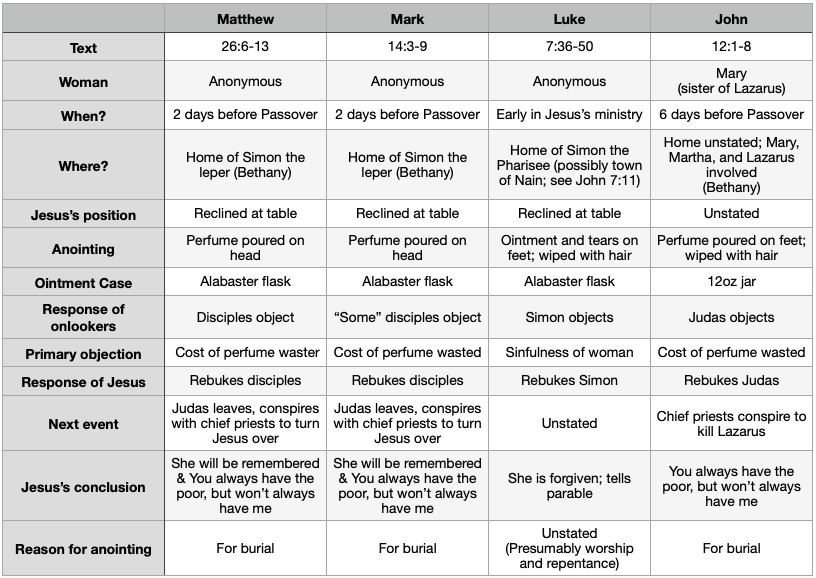The anointing of Jesus is a significant event recounted in all four Gospels. However, variations in the narratives raise questions: How many times was Jesus anointed? Do the Gospels describe one event or multiple? This in-depth Bible study compares the four Gospel accounts, seeking to harmonize the apparent discrepancies and uncover the deeper meaning of these pivotal moments.
 Comparison chart of Jesus' anointing in the four Gospels
Comparison chart of Jesus' anointing in the four Gospels
Harmonizing the Gospel Accounts: One Event or Several?
The four Gospels share striking similarities in their accounts of Jesus’ anointing, yet notable differences exist. Understanding these variations is key to a comprehensive understanding of the event. Some scholars propose three separate anointings, while others argue for two. This study will present evidence supporting the two-anointing theory.
Luke’s Unique Account: An Early Anointing by a Sinful Woman
Luke’s Gospel presents a distinct narrative, placing the anointing early in Jesus’ ministry. Several key factors differentiate it from the other accounts:
- Timing: Luke’s anointing occurs early in Jesus’ ministry, contrasting with the others occurring just before his crucifixion.
- Location: The event takes place in the home of Simon the Pharisee, a different location than the Simon the Leper mentioned in Matthew and Mark.
- Objection: The objection centers on the woman being a “sinner,” unlike the concern over wasted perfume in the other Gospels.
- Jesus’ Response: Jesus offers forgiveness and a parable about forgiveness, a stark contrast to his defense of the woman in the other accounts.
These significant distinctions suggest Luke describes a separate event.
Matthew and Mark: Two Accounts, One Event
Matthew and Mark’s narratives are nearly identical, differing only in the description of who objected. This minor variation doesn’t signify a separate event. Both accounts depict the anointing occurring in Bethany, at the house of Simon the Leper, just days before Passover. The objection concerns the cost of the perfume, and Jesus defends the woman’s act as preparation for his burial.
John’s Gospel: Reconciling the Differences
John’s account shares similarities with Matthew and Mark, placing the event in Bethany shortly before Passover. A woman anoints Jesus with expensive perfume, drawing criticism for the perceived waste. Jesus defends her, stating she has anointed him for burial. However, differences exist:
- Timing: John places the event six days before Passover, while Matthew and Mark indicate two days.
- Location: The location is unspecified in John.
- Specifics: John identifies Mary, sister of Lazarus, as the woman and mentions Judas as the objector. He also specifies the anointing was on Jesus’ feet.
Despite these differences, a closer examination reveals potential harmony. John doesn’t explicitly state the dinner occurred immediately upon Jesus’ arrival in Bethany six days prior. Matthew and Mark’s use of “when Jesus was in Bethany” allows for flexibility in the exact timing. The location, though unspecified in John, could still be Simon the Leper’s house, with Mary, Martha, and Lazarus hosting. Judas objecting doesn’t contradict others also objecting. The anointing of the feet could be a detail specific to John, highlighting themes of humility and service present in his Gospel.
Conclusion: Two Anointings, Profound Significance
This comparative study suggests two distinct anointings of Jesus: one early in his ministry recounted by Luke, and another shortly before his crucifixion described by Matthew, Mark, and John. While variations exist, these differences don’t necessarily indicate contradiction but rather offer unique perspectives on the same event. Both anointings highlight the profound devotion shown to Jesus and foreshadow his impending death and burial. The anointings serve as powerful reminders of the significance of sacrificial giving and the enduring legacy of acts of love and faith.